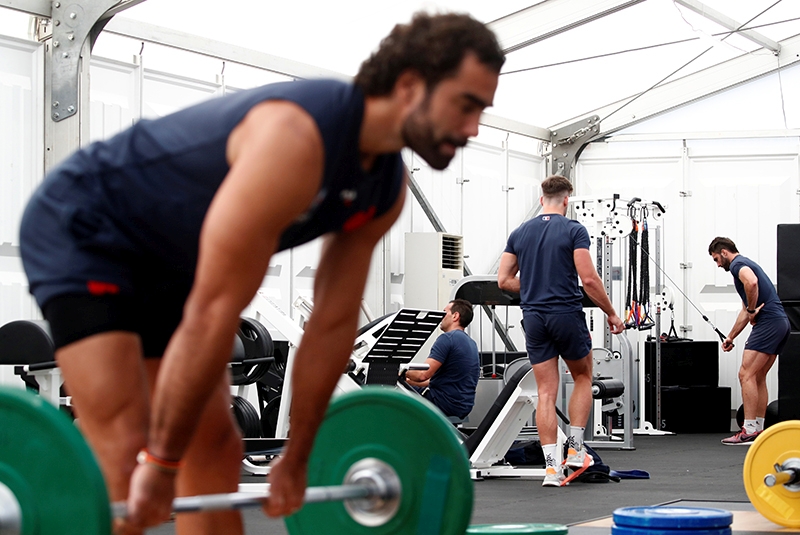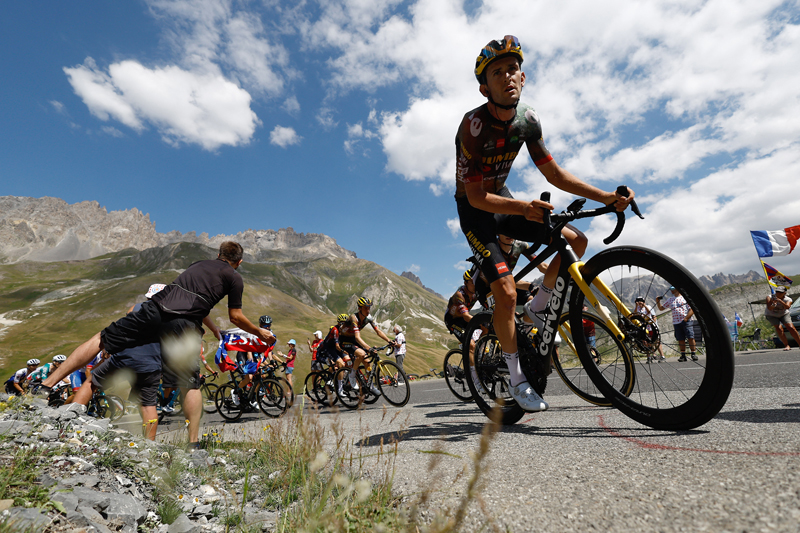You are viewing 1 of your 1 free articles. For unlimited access take a risk-free trial
Distance running: leg strength and critical mass

New research on thigh muscle mass and running performance suggests that a targeted approach to muscle conditioning is required
Without a doubt, the most important determinant performance of distance running performance is aerobic capacity. The maximal capacity to take in, transport and use oxygen in the muscles (so-called VO2max) plays a major role in determining how much energy can be liberated in the working muscles over a sustained period of time to produce muscle contraction and motion.Sprinting for distance performance
However, while high levels of aerobic fitness are essential for good distance running performance, what is less appreciated by many runners is that other factors also play a crucial role. It turns out that a high level of muscle efficiency is also a very desirable attribute in distance running. Although surprising, recent research has shown that national-level long-distance runners with excellent 100m and 400m sprint times were more likely to produce 5000 m seasonal best times(1). Moreover, previous research also found that the enhancement of 20m sprinting ability through nine weeks of explosive-type strength training improved the running velocity of distance athletes at maximal anaerobic capacity, as well as their 5km times(2).The reasons for the association between sprinting ability and long-distance running performance seems be that runners who run fast also possess superior running economy at high speeds – that is they require less oxygen to sustain a given pace because their muscles and tendons are more efficient at converting chemical energy released in the working muscles into mechanical forward motion – see this article on muscle efficiency. This explains why for example, training that combines heavy resistance and plyometrics exercises can improve 50m sprint times and high-speed running economy in well-trained long-distance runners(3).
What makes for good sprinting?
Given the relationship between good sprinting ability, and improved efficiency and performance in distance runners, the question arises of what determines sprinting ability, and how this ability might be trained with strength and conditioning exercises in distance runners to improve endurance performance? It turns out that in elite athletes at least, lower limb muscularity is a key factor that determines sprinting ability. For example, a 2018 study demonstrated that faster sprinters had a greater volume of hamstring (rear) muscles in their thighs(4). By contrast, there was no association between the athletes’ 100m sprint times and volume of the quadriceps femoris (frontal thigh) or adductor (inner thigh) muscles. These studies suggest therefore that when sprinting performance matters, the hamstring muscles should be prioritized over the quadriceps in any strength and muscle development program.This research also fits with previous studies suggesting that the hip extensor muscles (hamstrings and gluteals of the buttocks – the muscles that extend the leg behind the body, eg during the propulsive phase in running) are primarily responsible for propelling the body forward during sprinting(5). By contrast, the quadriceps muscles are not primarily involved in propelling the body forwards during running. Instead, research has found that they mainly contribute to braking the body during ground contact, whereas it is the hamstring muscles that are the primary generator of forwards propulsive force(6).
New research
If hamstring muscle mass primarily drives runners forwards whereas quadriceps muscle mass is used mainly for braking upon footstrike (with a small contribution to push-off as the foot leaves the ground), can a large volume of quadriceps muscle mass actually impair sprint running performance? And if so, does this mean that some methods of leg strengthening focussing on quadriceps strength could actually be detrimental for distance running performance? A new study published in the Journal of Human Kinetics titled: Thigh Muscularity and Sprinting Performance of National‐Level Long‐Distance Runners has tried to answer this question(7). In this study, Japanese researchers set out to examine the association between thigh muscle size and sprinting ability (and therefore running efficiency) in national-level male long-distance runners.Nineteen Japanese male long-distance runners participated in this study with average official personal best times for the 5000m and 10000m events of 13mins:45.77secs (range: 13:12.63–14:14.87) and 28mins:26.98secs (range: 27:29.69–29:06.64), respectively. All the runners were scanned using a whole-body magnetic resonance image (MRI) scanner. In particular, cross sectional scans (showing slices through the muscle) were taken at 30%, 50%, and 70% distances of the length from the greater trochanter to the lower edge of the femur thigh – ie at different points along the thigh. The cross-sectional scans also allowed the researchers to identify the quadriceps, hamstrings and adductor muscles (see figure 1 below); by averaging these out over the three points along the thigh, they were able to calculate the volume and mass of each muscle group in the scanned thigh.
Following the scanning procedure, sprint performance tests were performed on an all-weather track using a wireless phototube system to obtain the times. Participants wore their track spikes, and after performing warm-ups individually, the runners performed the 100m sprint from a standing position twice, with a 10-minute rest interval between trials. The better of the two times was then recorded. Participants then performed a 400m sprint from a standing start after 10 minutes of rest.
What they found
The key finding was that when the cross sectional areas of each muscle group were standardized (to correct for each runner’s overall body mass), there was a strong positive correlation between quadriceps volume and mass and the runners’ sprinting speeds. In plain English, greater quadriceps muscle mass was associated with slower 100m and 400m sprint times. Interestingly, while researchers expected the runners with greater hamstring muscle mass to turn in faster times, no apparent association was present. A likely explanation for this lack of association is that the previous research (showing higher levels of hamstring muscle mass predicting faster sprint times) has been carried out almost exclusively in sprinters – not long-distance runners. Since distance runners tend to be lightly muscled, spotting trends between hamstring muscle mass and performance is trickier because the difference between a ‘smaller’ and ‘larger’ hamstring, when overall muscle is low in both cases, is harder to detect.Also, sprinters run faster than long-distance runners – typically around 10.2–11.7 seconds for the 100m sprint compared to the 12.41– 14.34 seconds achieved by long-distance runners in the above study. Higher running speeds require greater levels of hamstring muscle torque (force) to generate that speed, which in turn require higher levels of muscle mass. Therefore, the hip extensor muscles of sprinters are usually hypertrophied, which could explain why there is a significant association between hamstring size and 100m sprint time in sprinters, but not long-distance runners.
Figure 1: Cross sectional MRI scans(7)

Representative magnetic resonance images at 50% of the thigh length of the runners having the fastest and slowest 5000m official personal records with (upper) and without (lower) anatomical markers. QF: quadriceps femoris, HM: hamstrings, AD: adductor muscles. Note the hamstring to quadriceps area ratio in the fastest runner was 0.53 (31.8/60) whereas in the slowest runner, it was just 0.36. The fastest runner therefore had a much better ratio of hamstring mass and strength to quadriceps mass/strength.
Implications for distance runners and coaches
This study is interesting for a number of reasons. Firstly, it’s the first study to demonstrate the relationship between thigh muscularity and sprinting ability in national-level long-distance runners. Secondly, the findings were rather unexpected. Based on the fact that heavy resistance training for the legs is known to help improve strength, muscle mass and running efficiency(8), the researchers had expected that higher levels of hamstring mass would predict better sprinting ability in the runners. Instead, the findings were inverted, in the sense that it was higher mass levels of the antagonist muscles (the quadriceps) that was associated with worse performance.But how can it be that resistance training exercises such as squats, which increase thigh (and therefore quadriceps) mass has been shown to improve both sprinting performance and running efficiency? The likely explanation is that exercises such as squats very strongly activate the hamstrings, producing greater relative gains in hamstring strength compared to quadriceps strength (watch out for a forthcoming article on why squats work for athletes). By contrast, exercises that primarily build strength in the quadriceps only (eg leg extensions, hack squats etc) develop braking ability the body during ground contact but don’t aid hamstring development, and therefore propulsive force. Therefore, quadriceps muscles that are trained and developed do not add propulsive force but do add undesired excess weight, thus adversely affecting power-to-weight ratio (see this article).
Practical recommendations
In terms of training for distance runners and their coaches, these results could be helpful to long-distance runners and their coaches. Given that runners with lower sprinting ability typically produce greater vertical force relative to propulsive force during the acceleration phase (and therefore cannot run as fast) training techniques that develop propulsive force without an increase in vertical force development should be considered. One method of achieving this is the use of weighted sled towing, which has been shown to actually decrease the vertical force generated by runners and improve their sprinting capabilities(9).Another technique for runners that can be considered is cycling with a high load/intensity, which has been shown to considerably activate the hip extensor muscles(10), thereby helping to develop the production of propulsive force during running. In addition, runners should try and ensure their strength training focuses on exercises that strongly activate the hamstrings and gluteal muscles, and avoids exercise such as leg extensions and hack squats that disproportionately develop quadriceps strength.
References
- International Journal of Sports Physiology and Performance. 2019;15:1
- Journal of Applied Physiology. 1999;86(5):1527–1533
- 2019;7:e6787
- International Journal of Sports Physiology and Performance. 2018;13(2):214–219
- Frontiers in Physiology. 2015;6:404
- Journal of Sports Sciences. 2005;23(10):1101–1109
- J Hum Kinet. 2022 Jan; 81: 65–72
- Sports Medicine. 2018;48(5):1117–1149
- Journal of Strength and Conditioning Research. 2014;28(10):2738–2745
- Journal of Electromyography and Kinesiology. 2019;44:64
Newsletter Sign Up
Testimonials
Dr. Alexandra Fandetti-Robin, Back & Body Chiropractic
Elspeth Cowell MSCh DpodM SRCh HCPC reg
William Hunter, Nuffield Health
Newsletter Sign Up
Coaches Testimonials
Dr. Alexandra Fandetti-Robin, Back & Body Chiropractic
Elspeth Cowell MSCh DpodM SRCh HCPC reg
William Hunter, Nuffield Health
Keep up with latest sports science research and apply it to maximize performance
Today you have the chance to join a group of athletes, and sports coaches/trainers who all have something special in common...
They use the latest research to improve performance for themselves and their clients - both athletes and sports teams - with help from global specialists in the fields of sports science, sports medicine and sports psychology.
They do this by reading Sports Performance Bulletin, an easy-to-digest but serious-minded journal dedicated to high performance sports. SPB offers a wealth of information and insight into the latest research, in an easily-accessible and understood format, along with a wealth of practical recommendations.
*includes 3 coaching manuals
Get Inspired
All the latest techniques and approaches
Sports Performance Bulletin helps dedicated endurance athletes improve their performance. Sense-checking the latest sports science research, and sourcing evidence and case studies to support findings, Sports Performance Bulletin turns proven insights into easily digestible practical advice. Supporting athletes, coaches and professionals who wish to ensure their guidance and programmes are kept right up to date and based on credible science.











